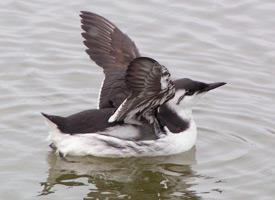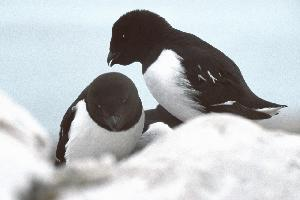
Poids et mesures
| Longueur | de 38 à 46 cm |
|---|---|
| Envergure des ailes | de 61 à 73 cm |
Description de l'animal
The Common Murre, Uria aalge, is a charismatic and significant member of the auk family, found abundantly in the cold waters of the Northern Hemisphere. These birds are highly adapted to marine life, spending most of their time at sea, except during breeding seasons when they come ashore to nest on steep, rocky cliffs.Physically, the Common Murre presents a sleek and streamlined body, perfectly designed for an aquatic lifestyle. Adults typically have a black or dark brown back and wings, contrasting sharply with their white underparts, creating a tuxedo-like appearance that is both elegant and striking. Their necks are long and slender, supporting a small round head with a pointed, dark bill, which is adept at catching fish. One of the most remarkable features of these birds is their ability to dive to great depths, often exceeding 100 meters, in pursuit of prey, using their powerful wings to propel themselves underwater.
The Common Murre's legs are set far back on their bodies, a feature that, while making them somewhat awkward and clumsy on land, turns them into efficient and graceful swimmers. Their feet are webbed, and when underwater, they move with a flying motion, using their wings as flippers. This adaptation allows them to chase down fish and squid with remarkable agility.
During the breeding season, Common Murres exhibit a fascinating social structure, nesting in densely packed colonies that can number in the tens of thousands. They display high fidelity to their nesting sites, often returning to the same spot year after year. Unlike many birds, murres lay their eggs directly on the narrow cliff ledges without constructing a traditional nest. Their eggs are uniquely pear-shaped, which prevents them from rolling off the cliffs, and are speckled with various colors and patterns, providing camouflage against predators.
The care of the young is a shared responsibility between both parents. The chick, once hatched, is brooded and fed by its parents for a few weeks until it is ready to fledge. In a dramatic rite of passage, the chick will leap from the nesting cliff into the sea, often hundreds of meters below, where it is met by the male parent. The two then swim together, sometimes covering vast distances, as the chick continues to be fed and taught the essentials of survival in the ocean.
Common Murres are not only fascinating creatures in terms of their physical adaptations and social behaviors but also play a critical role in the marine ecosystem. They are a key species in the food web, both as predators of small fish and squid and as prey for larger marine mammals and birds. However, they face threats from oil spills, overfishing, and climate change, which can affect their food sources and breeding habitats.
In conclusion, the Common Murre is a remarkable bird, embodying the harsh yet beautiful marine environments in which it lives. Its adaptations to life at sea, complex social behaviors, and the challenges it faces for survival are subjects of ongoing research and conservation efforts, highlighting the interconnectedness of marine ecosystems and the importance of preserving them.
Animaux similaires
Nouvelles photos d'animaux
Top 10 des animaux
- Dolphin gull (Leucophaeus scoresbii)
- Diana monkey (Cercopithecus diana)
- Moustached guenon (Cercopithecus cephus)
- Galápagos tortoise (Geochelone nigra complex)
- Japanese macaque (Macaca fuscata)
- Russian tortoise (Testudo horsfieldii)
- Stone loach (Barbatula barbatula)
- Greek tortoise (Testudo graeca)
- Common flying dragon (Draco volans)
- Vendace (Coregonus albula)


